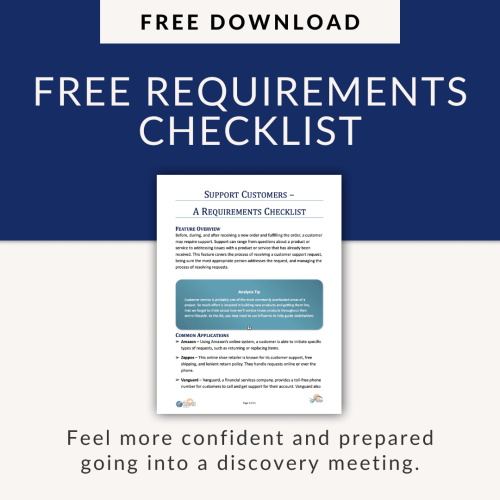Requirements life cycle management is the knowledge area that describes the tasks that a business analyst performs to manage and maintain requirements from initiation right through to final implementation.
The process includes monitoring, planning, analysing, managing, and communicating organisational requirements. So it’s clear that managing the life cycle of requirements can have a deciding impact on the outcome of the project. Managing requirements life cycle requires a business analyst to manage and maintain requirements while identifying relationships with designs, assessing changes, and helping reach consensus on those changes.
The objective of requirements life cycle management is to provide an environment where all of the analysis crucial elements – the business itself, stakeholders, requirements, and design are aligned with each other and ensure that the solution properly implements those requirements and designs. When conducted in the right way, requirements management doesn’t end with the implementation of the solution, but it continues to provide value as long as that solution is in use.
During requirements life cycle management, the business analysts employ all six of the key concepts

The BAs trace requirements to the solution components and align the solution with the need. During this process, they cooperate with interested stakeholders on the understanding and approval of requirements. The goal is to maintain requirements in a way that will provide future value and that is only possible through understanding the organisational context in which these activities take place.
The knowledge area of requirements life cycle management involves five tasks that a business analyst needs to perform: trace requirements, maintain requirements, prioritise requirements, asses requirements changes, and approve requirements.
Table of Contents
Trace Requirements
Tracing requirements involves analysis and maintaining relationships between requirements, designs, and solutions which should provide the basis for impact analysis, allocation, and coverage. The life cycle of every requirement needs to be identified and recorded in a way that ensures backward and forwards traceability. Through traceability, the business analyst can ensure that the solution is aligned to the requirement and manage the scope, timeline, risks, and potential costs.
It’s also helpful for discovering requirement inconsistencies and flaws and provides a better understanding of the change. Tracing enables the analyst to assess at any given moment if certain requirements have been addressed or not.
Requirements tracing is based on two key inputs – requirements that can be traced to other requirements, solutions, and other process components, and designs which can also be similarly traced. The completely traced requirements and designs are the expected outputs of this process.
The elements of requirements tracing are:
- Level of Formality
- Relationships
- Traceability Repository
The main guidelines and tools used for tracing the requirements are domain knowledge, information management approach, legal/regulatory information, and requirements management tools/repository. The techniques that the business analyst will most likely use are:
- Business Rules Analysis
- Functional Decomposition
- Process Modelling
- Scope Modeling
Tracing requirement requires the involvement of the following stakeholders: customers, domain subject matter expert, end-user, implementation subject matter expert, operational support, project manager, sponsor, suppliers, and tester.
Maintain Requirements
Maintaining requirements is necessary for keeping the requirements and designs accurate and current throughout the cycle. It also enables their reuse if needed.
Maintenance of requirements is crucial for preserving their validity through the process, especially since it represents a certain organisational need. To maximise the benefits of maintaining requirements, the business analysis must make sure that the requirements are consistently represented, approved, and reviewed using standardised procedures, and easy to access and understand.
Two inputs are key for requirement maintenance – requirements (goals, business requirements, stakeholder requirements, and transition, and solution requirements) and designs that are maintained throughout the whole process.
The main elements of requirements maintenance task are:
- Maintaining Requirements
- Maintaining Attributes
- Reusing Requirements
While maintaining requirements, the business analysts commonly use information management approach as a useful guideline or tool. Besides this, there are several helpful business analysis techniques:
- Business Rules Analysis
- Data Flow Diagrams
- Data Modelling
- Document Analysis
- Functional Decomposition
- Process Modelling
- Use Cases and Scenarios
- User Stories
The significant stakeholders at this stage of the business analysis project are domain subject matter expert, implementation subject matter expert, operational support, regulator, and tester.
Prioritise Requirements
Prioritising requirements or ranking them in order of importance helps business analysts assess the value, risk, and urgency related to certain requirements and designs. This ensures that the most important requirements and designs are always at the top of the queue for analysis. the relevance of the requirements to their stakeholders plays the most important part of their ranking and according to this, the requirement can be prioritised to a greater or lesser extent.
The ranking doesn’t just reflect the relevance of a requirement, but often their place in a project timeline. As the project moves on, and new changes and needs are introduced, the prioritisation can also change reflecting this process. The ultimate objective of requirements prioritisation is securing the maximum value for the stakeholders.
The crucial inputs for requirements prioritisation are requirements that are to be prioritised (in the form of text, diagrams, or matrices) and designs in similar forms ready for prioritisation. Prioritising requirements is expected to produce two key outputs; prioritised requirements ranked according to the highest value and prioritised designs that are also ranked similarly and ready for further work.
The task of prioritising requirements has three key elements:
- Basis for Prioritisation
- Challenges of Prioritisation
- Continual Prioritisation
When prioritising requirements use several guidelines and tools such as business constraints, change strategy, domain knowledge, governance approach, requirements architecture, requirements management tools/repository, and solution scope. There are also some useful BA techniques for this process:
- Backlog Management
- Business Cases
- Decision Analysis
- Estimation
- Financial Analysis
- Interviews
- Item Tracking
- Prioritisation
- Risk Analysis and Management
- Workshops
Stakeholders that have significance at this phase of the project are customer, end-user, implementation subject matter expert, project manager, regulator, and sponsor.
Assess Requirements Changes
When assessing requirements change, the business analysts evaluate every existing and potential new stakeholder requirement and design so they can make an informed decision whether an action on those requirements is required. Every change to the requirements and designs has its implications and analysts assess those changes to estimate the impact of those changes on the project. this task needs to be performed every time a new need arises or the possible solution is proposed.
Assessment of requirements changes helps understand how those changes increase or decrease the value of the solution and identify the potential steps to be taken. Also, it reveals possible conflicts or inconsistencies in relationships with other requirements. Each proposed requirement change needs to be checked for alignment with the overall strategy, the potential value for stakeholders, the impact on the delivery timeline, and possible influence on the risks, opportunities, and constraints of the whole project.
The inputs for requirements change assessments are proposed change, requirements, and designs. This task should produce outputs of requirements change assessment containing recommendations on approval, denial or modification, and design change assessment with similar recommendations.
The three main elements of the task of assessing requirements changes are:
- Assessment Formality
- Impact Analysis
- Impact Resolution
Guidelines and tools the business analysts use while assessing requirements changes are change strategy, domain knowledge, governance approach, legal/regulatory information, requirements architecture, and solution scope. The key business techniques of use here are:
- Business Cases
- Business Rules Analysis
- Decision Analysis
- Document Analysis
- Estimation
- Financial Analysis
- Interface Analysis
- Interviews
- Item Tracking
- Risk Analysis and Management
- Workshops
The stakeholders that are important for assessing requirements changes are customer, domain subject matter expert, end-user, operational support, project manager, regulator, sponsor, and tester.
Approve Requirements
During the approving of the requirements, the business analysts work closely with the stakeholders with the role in the governance process to approve and agree on certain requirements and designs. reaching the agreement and obtaining approval is crucial for the continuation of the business analysis process.
Analysts are required to provide the understanding and unambiguous communication of any information on requirements and designs needed for stakeholders’ approval. The approval itself can be formal or informal and the time when it occurs depends on the business analysis approach taken – predictive or adaptive.
The inputs for requirements approval are verified requirements and designs. The task should end with the output of approved requirements and designs.
The elements of the requirements approval task are:
- Understanding Stakeholders Roles
- Conflict and Issue Management
- Gaining Consensus
- Tracking and Communicating Approval
Business analysts can make use of the following guidelines and tools for requirements approval: change strategy, governance approach, legal/regulatory information, requirement management tools/repository, and solution scope. Business analysis techniques that will most likely be used are:
- Acceptance and Evaluation Criteria
- Decision Analysis
- Item Tracking
- Reviews
- Workshops
The stakeholders that are important for requirements approval are customer, domain subject matter expert, end-user, operational support, project manager, regulator, sponsor, and tester.
Requirements Management Template
Business Analysis Doctor has a business analysis & requirements management planning template, requirements traceability matrix template and requirements prioritisation matrix template included a business analysis template package
Conclusion – Requirements Life Cycle Management
Requirements life cycle management describes the tasks that business analysts perform in order to manage and maintain requirements and design information.
Learn more about the other IIBA business analysis knowledge areas:




